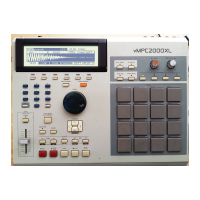Page 3
Chapter 1: Introduction
Sequencer
• Loop recording function enables quick recording by looping short phrases.
• Sequencer memory equivalent to 300,000 notes (including note and other data).
The maximum number events in a sequence is equivalent to 50,000 notes.
• 99 sequences may be held in memory at once. Each sequence contains 64 individual
tracks.
• 2 independent MIDI output ports permit 32 simultaneous MIDI output channels.
• 2 mergeable MIDI inputs.
• The optional SMPTE IC chip (IC-M2TC) enable synchronization with SMPTE time codes.
• MTC (MIDI time code), MMC (MIDI machine control) compatible.
• Data can be exported to or imported from standard MIDI files.
• Step edit function enables you to edit individual events.
• The velocity of each track can easily be modified.
• It is possible to record to 32 MIDI channels at one time.
• Tap Tempo feature allows the playback tempo to be set by tapping a key in the time of 1/4-
notes.
• Programmable tempo changes in mid-sequence or mid-song are supported.
• Auto Punch feature enables you to punch in or punch out automatically in the designated
sequence.
• Swing feature enables you to add a swing-feel to the rhythm.
• 16 velocity- and pressure-sensitive front panel drum pads and 4 pad banks provide a total
of 64 pad/bank combinations.
• Track mute can be turned on or off and sequences can be selected using the drum pads.
• The NOTE VARIATION slider controls the decay or filter value of the sound in real time.
• Since it is possible to convert MIDI sustain pedal data to note duration data, you can place
sustain effects independently from the note data within a track.
• The note repeat function and the after touch function pads enable you to easily enter drum
rolls and hi-hat beats.
• The UNDO SEQ key enables you to undo sequence recordings or edits.
• The 2nd sequence function allows a separate sequence to be played at the same time that
another sequence (or song) is being played/recorded.

